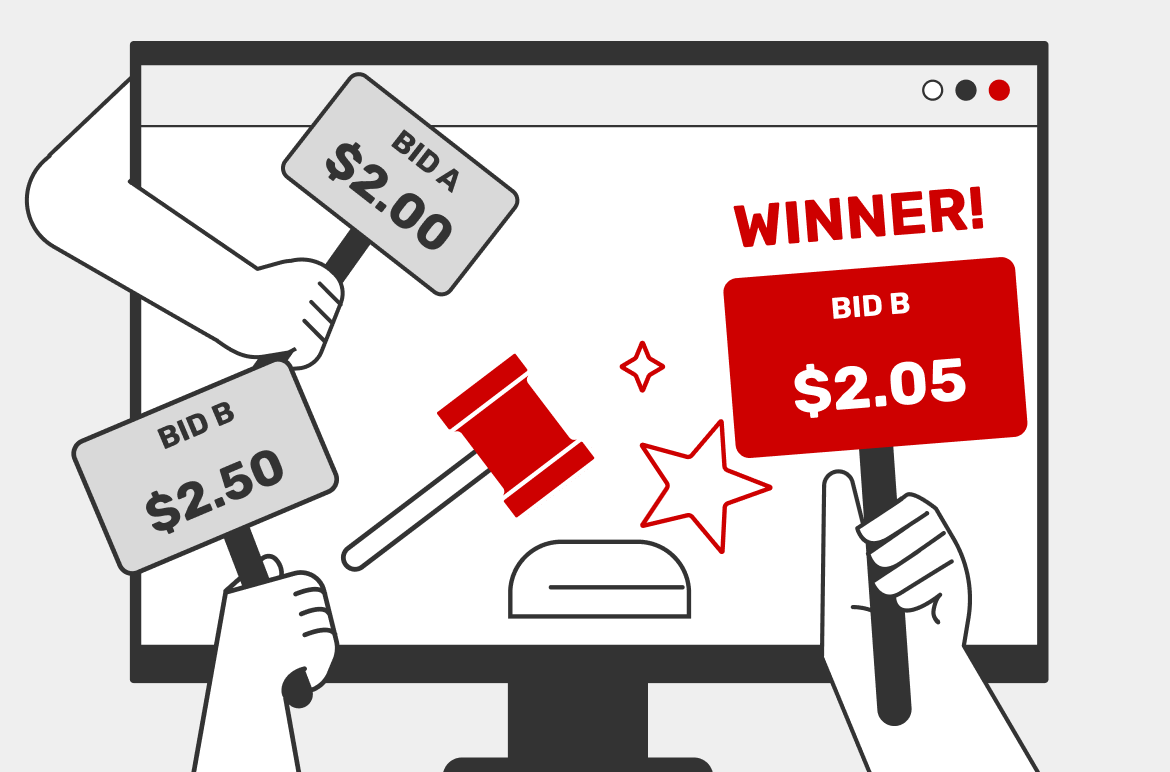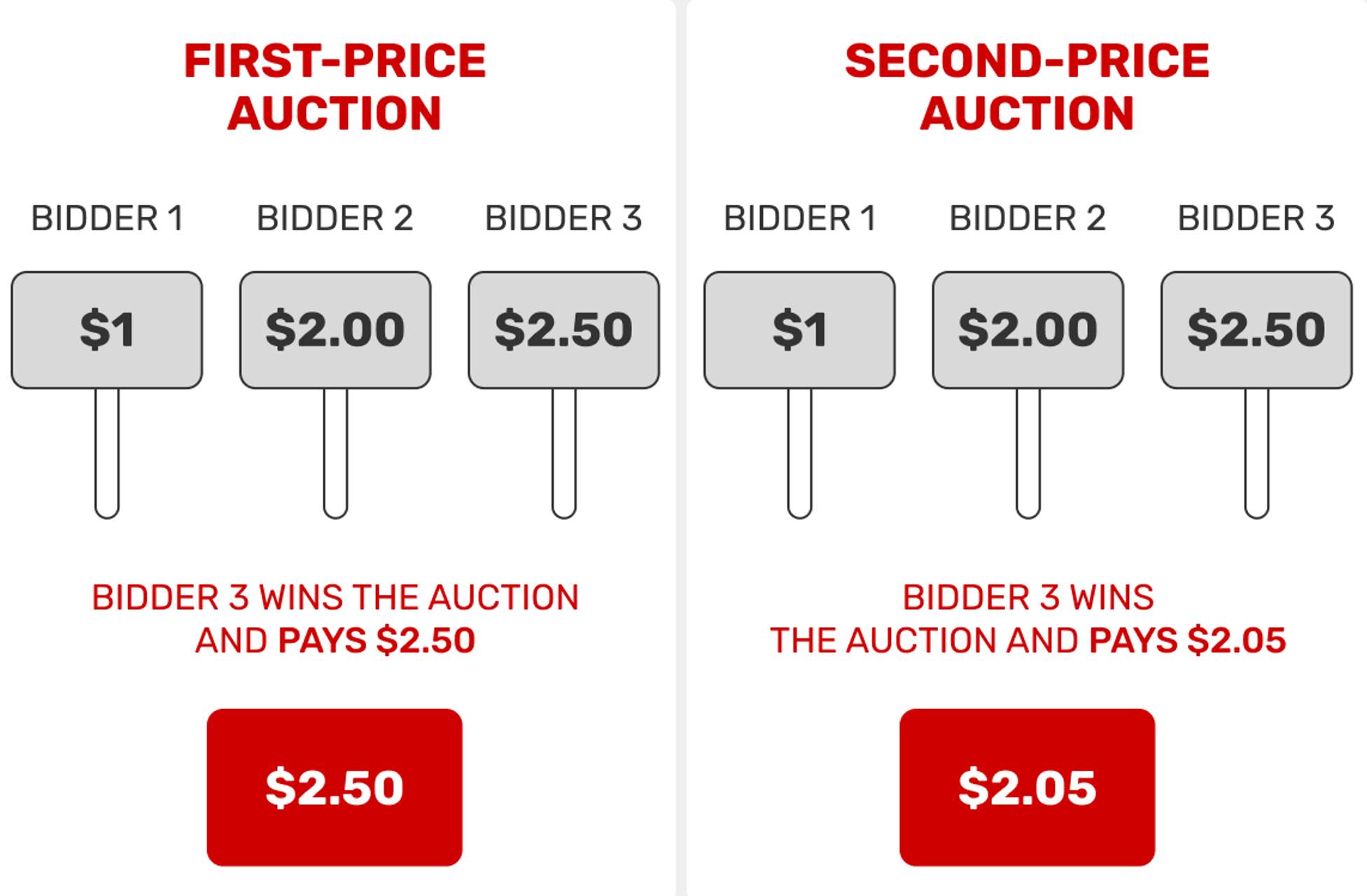A second-price auction model makes it easier for advertisers to win valuable ad slots at a better price. After winning the auction, you’ll pay slightly more than the next-highest bid instead of your original bid. Tune in as we explain how to utilize this cost-effective strategy to promote your brand effectively.
What is a second-price auction?
A second-price auction is a pricing model in which the highest bidder wins but pays the second-highest bid plus a few cents on top. The winning bidder pays only the necessary amount to beat the nearest competitor.
A second-price auction is common when bidding for competitive ad slots. It enables businesses to pay just enough to beat the competition instead of unusually high amounts.
Gain access to a network of 35,000+ high-quality publishers in high-value niches like E-commerce, Utilities, and iGaming. Advertise to your perfect target audience using Smart CPM, a second-price auction tool.
How does a second-price auction work?
A second-price auction is cost-effective because the highest bidder pays the second-highest bid plus 1 to 5 cents, depending on the ad network. It’s different from a first-price auction, where the highest bidder pays the exact amount they bid.
Here’s an illustration of a second-price auction with three bidding advertisers:
Advertiser C has the highest bid and wins the auction. However, instead of paying $2.50 for the ad slot, they’ll pay the second-highest bid plus $0.05, or ($2.00 + $0.05) = $2.05.

Second-price auctions can have a bid floor, i.e., the minimum price an advertiser must bid. This bidding model encourages advertisers to submit bids that reflect the truthful value they place on ads instead of submitting random and unusually high bids.
The difference between first-price and second-price auctions
You can easily tell the difference between first-price and second-price auctions from the names.
In a first-price auction, the highest bidder gets the ad slot and pays the exact amount they bid for it. This simple model determines the cost of the ad slot.
In a second-price auction, the highest bidder still wins the ad slot. But, instead of paying the amount they bid, they pay the amount of the second-highest bid plus a few cents.

The appeal of a second-bid auction is that you only pay what other competitors are willing to pay for an ad slot. It differs from a first-price where you might price an ad slot too high and overpay more than your competitors.
What are the benefits of second price auctions?
The primary benefit of a second-price auction is that it encourages fair bidding. Advertisers have less incentive to manipulate bids when they know they’ll only pay a few cents more than the next-highest bidder. In contrast, advertisers can be tempted to manipulate first-price auctions because they want to secure the slot at all costs.
Adsterra offers a Smart CPM second-price bid model that helps advertisers maximize their budgets. With this feature turned on, your ad payout will automatically be readjusted in line with competitors, ensuring you don’t overbid at crucial moments.
Other benefits of a second-price auction include:
Automation
The ad bidding process becomes automated, saving you the stress of frequently adjusting payouts to keep up with competitors.
Accurate value estimation
This auction model enables advertisers to know the true value of an ad space, which may be higher or lower than initially thought.
What are the disadvantages of a second price auction?
Complexity
In a second-price auction, advertisers may find it challenging to strategize because of the indirect relationship between their bid and final payment.
Traffic volumes volatility
If you’re an affiliate marketer reporting with specific KPIs like traffic volumes, you might find it more predictable to buy classic CPM traffic. In this case, you bid with a fixed high price for all ad placements within your targeting and get top ad slots and traffic volumes. With Smart CPM, you will still get the same volumes on average, but there may be slight drops.
Bid strategies in second price auctions
Here are some bidding strategies to apply in a generalized second-price auction:
1. True value bidding
This involves bidding the true value you place on an ad slot, i.e., the maximum amount you’re willing to pay. For instance, if you believe an ad slot is worth only $3, bid that amount. You might lose the bid, but the upside is that you don’t overshoot your budget.
2. Bid shading
This strategy entails submitting a bid lower than the advertiser’s true value to reduce the final price. It enables advertisers to win auctions at lower prices and gain a competitive edge.
Most advertisers don’t know the true value of ad slots when bidding for them. If someone bids the highest price and observes other advertisers bidding significantly lower, they might be compelled to reduce their own bid. That’s the essence of bid shading. We’re referring to the manual process of bid shading, not the algorithmic type used in programmatic advertising.
3. Dynamic bidding
You can adjust your ad bid dynamically based on competitive trends. For example, if you observe a sudden influx of competing bids, you can increase your bid to a significantly higher level to improve your chances of winning.
Adsterra’s Smart CPM bidding ensures your campaign payouts are priced dynamically with the competition to improve your chances of winning bids.
4. Bid experimentation
Experiment with varying bid amounts and observe which results in a winning bid. Then, stick to the range of the winning bid.
5. Custom Bidding
Custom bidding entails using different bids for different traffic sources (ad placements) and locations to maximize conversions. For example, you can place a higher bid for a specific website that drives better conversions or for high-value locations that generate more sales. This way, you’ll spend more money on high-value traffic sources and locations and less on the sources and locations that don’t generate many conversions. Adsterra’s Custom Bid feature helps you maximize your advertising budget.
6. Auction segmentation
Segment your advertising bids according to different factors, such as device type, time of day, location, age, etc. This strategy improves your bidding efficiency because it optimizes for different audience preferences.
Conclusion
Second-price auctions are a more efficient way to bid for ads. They allow advertisers to reduce costs and achieve more with less budget. Adsterra offers a second-price auction model called Smart CPM, enabling you to optimize your ad bids dynamically with competitors.
